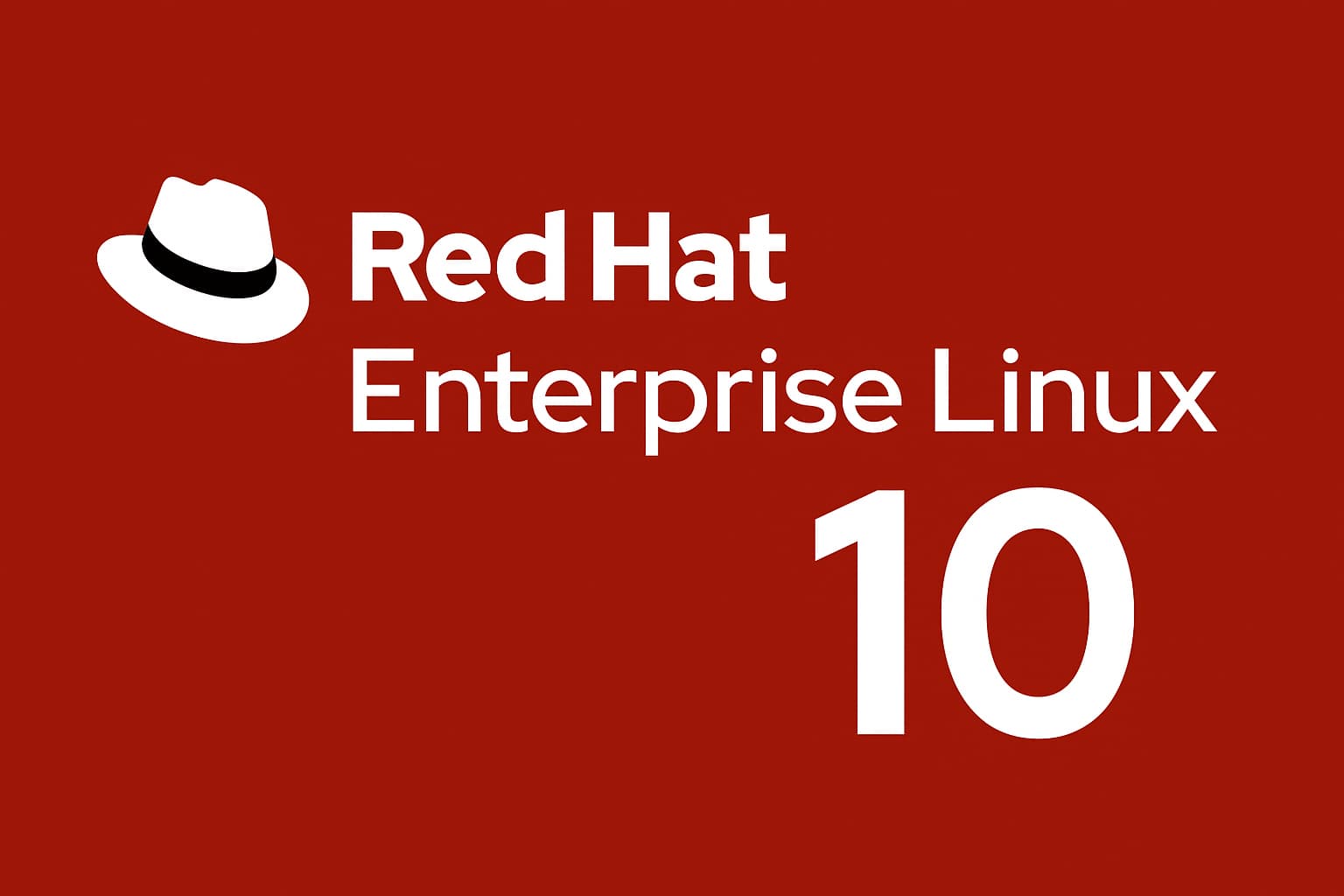Red Hat Enterprise Linux (RHEL) v10

Red Hat Enterprise Linux (RHEL) v10
Red Hat Enterprise Linux (RHEL) v10: The Future of Enterprise Operating Systems
One of the most reputable and popular enterprise-grade Linux distributions worldwide is Red Hat Enterprise Linux (RHEL). It drives vital systems in a variety of sectors, including cloud infrastructure, healthcare, finance, and government. Red Hat improves RHEL with every version to satisfy the needs of contemporary enterprise workloads. An important turning point in the development of enterprise operating systems will now be reached with the impending release of RHEL v10.
Your Future Starts Here – Reserve Your FREE Demo Class Now!
![]()
What Is Red Hat Enterprise Linux (RHEL)?
Red Hat, an IBM company, created RHEL, a commercial Linux distribution designed for dependable, secure, and high-performance business settings. It offers:
- Enterprise-grade security features,
- Stability throughout the lifecycle and long-term support,
- Certification for a variety of software and hardware suppliers,
- Integration with cloud computing systems such as Google Cloud, AWS, and Azure.
What’s New in RHEL v10?
RHEL 10 has not yet been formally published by Red Hat, but based on early roadmaps and community expectations, it is anticipated to bring revolutionary improvements in a number of important areas:

- AI & Machine Learning Optimization
RHEL 10 is expected to include:
- Integrated libraries and assistance with AI/ML tasks,
- Improved compatibility with hardware accelerators and GPUs,
- Optimized settings for programs like ONNX, PyTorch, and TensorFlow.
- Cloud-Native and Container-First Architecture
It is anticipated that RHEL 10 would enhance compatibility with cloud-native technologies like:
- Buildah, Skopeo, and Podman for container management,
- Simplified assistance with Kubernetes and OpenShift,
- Versions of lightweight images for hybrid and edge deployments, etc.
- Improved System Performance
RHEL 10 may ship with:
- A Linux kernel of the next generation (probably 6.x+),
- Improved scheduling of the CPU and memory for multi-core processors,
- Increased I/O throughput for SSD and NVMe storage, etc.
- Zero Trust and Enhanced Security
Security will continue to be a top priority:
- Enhanced AppArmor and SELinux controls,
- Live patching and automated vulnerability scanning,
- Greater adherence to the Common Criteria and FIPS,
- Improvements to rootless container security and secure boot, etc.
- Smaller Footprint for Edge and IoT
It is anticipated that RHEL 10 will facilitate embedded and edge deployments with the following:
- A scaled-down version of CoreOS,
- Improved offline upgrades and remote management capabilities,
- Improvements to the kernel in real time for apps that are sensitive to latency, etc.
System Tools & DevOps Enhancements
In RHEL 10, Red Hat is probably going to expand automation and tooling, which will include:
- Ansible automation for compliance and configuration,
- Enhanced compatibility with predictive analytics from Red Hat Insights,
- Tools for modern CLI and GUI that make system monitoring simpler, etc.
Lifecycle & Upgrade Experience
Usually, Red Hat provides:
- The 10-year support lifecycle consists of five years of maintenance support and five years of full support.
- Stable routes for upgrading from earlier iterations, such as RHEL 8 and RHEL 9.
- Enhanced system rollback capabilities and rolling upgrades for high-availability systems, among other things.
RHEL 10 and the Hybrid Cloud Era
For the upcoming IT era, RHEL 10 is being developed with:
- Hybrid and multi-cloud capabilities out of the box,
- Improved scalability in cloud, virtual, containerized, and bare-metal environments,
- Unified system administration across cloud, edge, and on-premises platforms, etc.
Who Should Use RHEL 10?
RHEL 10 is ideal for:
- Big businesses in charge of vital infrastructure,
- Cloud-native programmers creating safe, containerized apps,
- DevOps groups that are looking for observability, automation, and stability,
- Government agencies, compliance-focused businesses, etc.
FAQs
About Red Hat Enterprise Linux (RHEL) v10
1: What is the difference between RHEL 9 and RHEL 10?
Significant improvements over RHEL 9 are brought forth by RHEL 10, including:
- Improved optimization of the AI/ML workload,
- Enhanced support for cloud-native and container technologies,
- An advanced zero-trust security framework,
- Improved support for edge computing and real-time applications,
- Increased efficiency on next-generation hardware (ARM, RISC-V), etc.
RHEL 10 is intended to be more future-proof with intelligent automation and hybrid-cloud scalability, whereas RHEL 9 concentrates on cloud readiness and security.
2: What is new in RHEL 10?
Among the main anticipated features of RHEL 10 are:
- Combined GPU optimization with AI/ML technologies,
- Enhanced security for rootless containers,
- OS versions that are lightweight and edge-ready,
- Enhanced kernel functionality and real-time patching,
- Smooth interaction with Ansible, Podman, and OpenShift, etc.
RHEL 10 seeks to provide a stable platform for safe workloads, DevOps, and contemporary IT infrastructure.
3: What is the name of RHEL 10?
RHEL 10 is simply referred to as Red Hat Enterprise Linux 10 in accordance with Red Hat’s naming guidelines. Although code names may be used internally or while the version is being developed, “RHEL 10” is the official name.
4: What is Red Hat Enterprise Linux used for?
RHEL is used in enterprises for:
- Executing vital databases and apps,
- Hosting cloud and online services,
- Constructing environments that are containerized,
- Overseeing a safe and legal IT infrastructure,
- Providing pipelines for development, DevOps, CI/CD, etc.
It is widely used in industries like cloud services, finance, government, healthcare, and telecommunications.
5: What is Red Hat Linux best for?
The best uses for Red Hat Linux are:
- Servers and infrastructure of enterprise quality,
- Steady and safe surroundings,
- Deployments of hybrid and multi-cloud systems,
- Computation with high performance (HPC),
- Real-time systems and edge computing, etc.
It is perfect for production systems due to its reputation for security, dependability, and long-term support.
6: Is RHEL 10 released?
RHEL 10 has not yet been formally released. Launching after Red Hat’s usual three-year major release cycle, it is anticipated to happen in late 2025 or early 2026.
7: Why is RHEL so popular?
RHEL is well-liked because of:
- It provides ten years of sustained assistance,
- Offers unwavering stability and security,
- Includes a thorough vendor certification,
- Works nicely with automation tools, containers, and cloud platforms.
- Supported by Red Hat’s ecosystem and enterprise support, among other things.
Many people in mission-critical settings trust it.
8: What is the life cycle of RHEL?
The 10-year support lifespan of RHEL is divided into:
- Full Support Phase (Years 1–5): Bug fixes, hardware enablement, and feature upgrades.
- Maintenance Support Phase (Years 6–10): Urgent bug fixes and security patches,
For versions older than ten years, additional Extended Life Cycle Support (ELS) is offered.
Conclusion
One of the most innovative and secure iterations of Red Hat Enterprise Linux to date is Red Hat Enterprise Linux v10. RHEL 10 provides a platform for innovation that is ready for the future, whether you are managing cloud apps, operating data centers, or deploying secure edge devices.
As Red Hat maintains its position as a pioneer in the open-source community, RHEL 10 offers unparalleled security, flexibility, and dependability, making it the perfect option for companies navigating the intricacies of contemporary IT.
Moreover, if you wish to get an introductory RHCSA Certification Training from an accredited training partner of Red Hat, then Craw Security is your answer for all problems. At Craw Security, we deliver quality training and cost-friendly solutions for certification voucher purchases and other facilities under a single roof. Hence, rather than searching for a perfect learning solution for yourself, just give us a call at our hotline number, +91-9513805401, or visit the Official Website of Craw Security and have a word with our superior team of study counselors to learn more about the upcoming batches and useful stuff at your earliest convenience.














